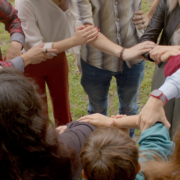This post is the third of four articles designed to help you effectively lead large group programs.
- What’s So Special About Large Groups?
- Essential Tips for Working with Large Groups – Part 1
- Essential Tips for Working with Large Groups – Part 2 (this one)
- How To Get Your Group’s Attention
Continuing on from last week’s post, the following strategies capture what I believe to be the most useful, practical advice for working effectively with groups, no matter their size, but especially if they are large.
There are ten tips & tricks in all, drawn from my book Count Me In: Large Group Activities That Work.
6. Position Yourself Strategically
A subtlety can explain much of the success achieved by an ‘expert’ (regardless of the field they perform in.) In the realm of programming, here are five key subtleties to take serious note of when it comes to strategically positioning yourself in relation to your group.
- Circles are good. Generally speaking, standing as part of a circle, your group has the best chance of not only seeing you, but everyone else in the group. This will lead to engagement and interest. However, hearing you may be another issue. In my experience, once a group numbers 70 or more people, this technique starts to grow whiskers.
- Always look into the sun or towards a bright / back-lit background. Yes, it will be more difficult (for you) than if you had the awkward brightness behind you, but if this was the case, you’d end up with many more people looking anywhere other than at you. Which is tantamount to standing in front of a naked body and expecting everyone to focus on you (unless you are the one naked!). And then you’ll berate the group for not listening to you. Dumb.
- Stand looking towards the most interesting part of the room/playing field, etc. Again, this strategy attempts to drive the focus towards you as much as possible and not have to compete with, for example, gorgeous balcony views, television shows, passers-by, traffic, a meal being prepared, etc.
- Tell a secret. I love lowering my voice and inviting my group to “bunch on in” around me. The closer my group gets, the more energy and intimacy they will generate, the less I have to project my voice, and most importantly, the more excitement I can build into my patter.
- Stand upwind. On a windy day, stand so that the wind may carry your voice towards your group.
7. Break It Up
Owing to issues of attention deficit, distractions, and the possibility that maybe not everyone can hear you, break everything you need to say into little chunks. Tell them only what they need to know when they need to know it.
And apply the well-known saying – a picture tells a thousand words. Provide many practical examples of what to do and what it looks like. This tip alone saved me countless hours of translation with many non-English speaking populations. Invite a volunteer from the crowd – this is a surefire way to engage your group.
Your goal should be to brief your group’s experience and not have to field any questions at the end. This will take many years to perfect, but it’s a worthy goal.
That said, don’t be afraid to start an activity if you feel that a few people are confused. Oftentimes, these people will get it once they see others doing it. And if not, you can respond accordingly while everyone else is occupied.
8. Preserve The Adventure
To follow on from this last point, maintain as much mystery and adventure (ie unanticipated outcomes) in your program/approach as possible.
Half of the fun of a truly successful program is found in the rudiments of surprise and discovery of what you do and don’t do. Everything from inviting a volunteer from the crowd before you have described what they are being asked to do, to keeping the punch line (so to speak) of your activity right to the end. This approach will engage people and build excitement. And when facilitated well, engagement promotes discovery and learning. It can often be the difference between “What are we doing next?” and “Oh no, not that again.”
This tip applies equally across the board, regardless of how big your group is, but especially with large groups because you are dealing with significantly more forceful energy. Large groups possess a life of their own, where you can ride the crest of a wave one minute and smash into the surf the next. Remember, play in its purest, most innocent form is not often experienced by many people today. So any hint of ‘we’re-about-to-play-something’ may cause some people to run in the other direction.
Aim to pique their interest, invite them forward, tease them almost. And before they know it, your group is more likely to be doing something that, if they had known what it was in advance, would not have come to so easily. And, this is just a guess, but I reckon that most of these initially reluctant people are grateful in the end.
9. Hydrate, Hydrate, Hydrate
Your voice is a finely tuned instrument and one of your most vital tools as a program leader. It will not be there when needed if you don’t look after it.
Short of advising you to check into a voice-care workshop, I strongly recommend that you sip and drink lots of water – during ALL of your program. You should drink at least two litres (half a gallon) of water every day anyway, so plan to drink a lot more if you are exercising your voice.
I also recommend drinking copious amounts of water before the program starts because it can take at least 30 minutes for the water to hit your vocal folds. If your voice hurts after a program, this will point to one of three issues – not drinking enough water, over-taxing your voice (read ‘Being Heard’ tips here,) or not breathing properly (in which case, you’ll need to seek professional advice.)
10. Be Adaptable
Finally, let go of the idea that everything will run perfectly. It won’t.
The ‘program’ will always require constant attention to changes within the group (and not necessarily for the worse.) And that’s OK, provided you don’t stress over it. Simply adjust your program on the run, keeping your group’s goals in mind at all times.
This advice is worthy of all program providers, but especially for those who work with large groups because, based on my experience, the mantra ‘stuff happens’ multiplies in proportion to the number of people standing before you.
BONUS Strategy
This concludes my list of ten essential tips for working with large groups effectively.
But wait, there’s one more…
Stay tuned for next week’s bonus post, in which I share 8 x fun attention-getting strategies you can use, all without losing your voice.
How To Work with Large Groups & Survive
Essential Large Group Tips: Part 1
8 Fun Ways To Get Your Group's Attention
No Comments

No Props No Problem
Best-selling book featuring 150+ fun group games & activities. Scan QR codes to access digital content including videos.

NEW – EMOJI Cards
Brand new deck of cards featuring emoji images to help you inspire conversations about emotions, feelings & experiences.
Top Ten Icebreakers & Group Games
Download our free 28-page ebook jam-packed with outrageously fun activity ideas.
Just one more question:
I am interested in…
Essential Tips for Working with Large Groups: Part 2
Share this with friends and colleagues.
Choose a plan that’s right for you
We offer a range of membership plans with no surprises.
Click an option below & discover our simple pricing.

Individual
Click here if you’re a:
- Teacher
- Corporate trainer
- Outdoor educator
- Camp leader
- Youth leader
- Conference organiser
- Therapist/counsellor
Membership Plans

Enterprise
Click here if you represent a:
- School
- Corporation
- Community-based Organisation
Explore plans for
10, 50, 200 or more
potential users
Membership Plans









Original post July 2023, last updated March 2024.